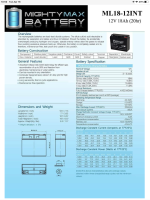Freemasm
Well Known Member
Background
There was a thread about a main bus (starting) battery application here:
https://vansairforce.net/threads/39...out-of-my-o470-yesterday.226634/#post-1766688
Discussion followed regarding suitability related to some specs, specifically max charging current. (reference attachment below) OK, fine. I won't rehash the EE based arguments.
Question
I will rehash my unanswered question/theory. After looking at all of the related specs:
Short circuit current 850A. - Assumed time ~ instantaneous
Max discharge current 225A. - Time listed as 5s and a 25C operating temp
Max charging current 6.8A. - No time listed (assume infinite) or operating temp
It seems to me this limits are more likely due to materials of construction related limits versus the EE limits/discussions that followed:
Amps + ohms = heat. Power (not energy) is a function of time
Guessing the associated battery materials have "time at condition" limits for heat/temperature which seems to be reinforced by the stated/assumed times related to charging rates. I also assume the pass/fail is a moving target probably ranging from contained damage to no measurable degradation.
It appears that the other read has wrapped up. While theories are welcome, does anyone have answers to the basis for these limitations?
FYI. The battery that was used for comparison as being an acceptable application did not list these parameters/values, at least as far as i could find on their website.
Help a EE challenged brother out, here. Please.
Edit = Point of clarity. I'm not advocating any battery model vs another. Trying to get smarter.

There was a thread about a main bus (starting) battery application here:
https://vansairforce.net/threads/39...out-of-my-o470-yesterday.226634/#post-1766688
Discussion followed regarding suitability related to some specs, specifically max charging current. (reference attachment below) OK, fine. I won't rehash the EE based arguments.
Question
I will rehash my unanswered question/theory. After looking at all of the related specs:
Short circuit current 850A. - Assumed time ~ instantaneous
Max discharge current 225A. - Time listed as 5s and a 25C operating temp
Max charging current 6.8A. - No time listed (assume infinite) or operating temp
It seems to me this limits are more likely due to materials of construction related limits versus the EE limits/discussions that followed:
Amps + ohms = heat. Power (not energy) is a function of time
Guessing the associated battery materials have "time at condition" limits for heat/temperature which seems to be reinforced by the stated/assumed times related to charging rates. I also assume the pass/fail is a moving target probably ranging from contained damage to no measurable degradation.
It appears that the other read has wrapped up. While theories are welcome, does anyone have answers to the basis for these limitations?
FYI. The battery that was used for comparison as being an acceptable application did not list these parameters/values, at least as far as i could find on their website.
Help a EE challenged brother out, here. Please.
Edit = Point of clarity. I'm not advocating any battery model vs another. Trying to get smarter.

Last edited:






